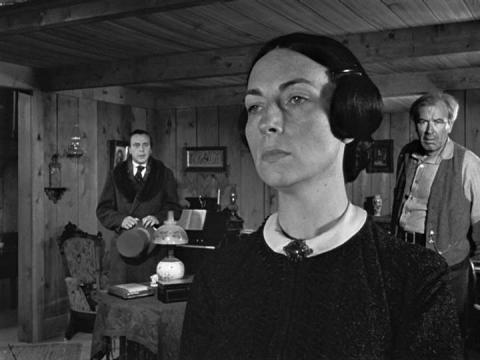Wisconsin's Own Agnes Moorehead!

This essay on Agnes Moorehead and her performance in Citizen Kane was written by Evan Davis, UW Alum and former Cinematheque staff member
What is there left to say about Citizen Kane, the “greatest movie ever made” (or second-greatest, depending on who you read)? The stories of its production and release have been visited and re-visited, refuted and affirmed, analyzed and and analyzed and analyzed. On a personal level, the film was my cinephile origin story: A late-night viewing in September 2001, at the raw age of 16, changed my life forever. But even that experience has been picked through in the dark corners of my own psyche. Orson Welles’s first feature is a bleached skeleton on the dried riverbed of movie history, the vultures fat and happy from their feast. So I’m just going to talk about Agnes Moorehead, the most underrated actor of her generation.
Moorehead has deep Wisconsin roots. Her family moved to Reedsburg from St. Louis in 1919, when Moorehead was a young woman. She earned a Master’s degree in English at UW-Madison, working as a teacher throughout her young life. She studied acting at the American Academy of Dramatic Arts in New York, and just before turning 30, she decided to chase her childhood dream of being a star. But it wasn’t to be, not at first, anyway. Moorehead struggled to find work, going hungry for much of those early years in New York. Radio gave her a steady paycheck, and in 1937, the 36-year-old Moorehead met a hotshot 22-year-old theatre director who would become the catalyst for her nascent career: Orson Welles. Moorehead spent two years as part of the Mercury Theatre on the Air and Campbell Playhouse cast, in addition to playing Margo Lane opposite Welles’s Lamont Cranston in The Shadow. When Welles uprooted Mercury to Hollywood in late 1939, Moorehead went along. Citizen Kane was their first film, and dear old Agnes was off and running.
Moorehead’s role in Kane is not exactly a large one based on screen time; she’s in only one scene—two shots total—for all of four minutes. But as Mary, the mother of Charles Foster Kane, she may have the most important role in the whole film. She is, after all, the psychological engine that drives Kane for the rest of his life, the symbol of lost innocence, of love never received; Rosebud in the flesh.
Moorehead has to make quick work of her time onscreen in order to convey the importance of Mary’s position in relation to young Charlie, but also the importance of the decision she makes. Welles helps anchor those acting choices by using the famous long-take, reverse tracking shot that keeps the young Kane perfectly framed in the boarding house window while Mary signs her brand-new gold fortune—and Kane’s legal guardianship—over to Walter Thatcher’s (George Coulouris) bank in the foreground. Watch Moorehead in this first shot, the icy resolve in her face, curtly shutting down Kane’s father, Jim (Harry Shannon). It’s all business, an investment made for future return. Jim subtly shuts the window as she signs the papers, closing the link between Mary and Charles, however briefly. And in a feat of pure, unbridled power, the camera tracks forward again as Mary goes to open the window, restoring the maternal bond.
It’s the first part of that second shot where you realize that Mary Kane is not simply a woman doing what she thinks is best for her son, but is bearing the full, tragic weight of that decision. A part of her is being severed. She stares out the window in medium-close-up, Thatcher and Jim in deep-focus midground, framing her. She maintains the same steely resolve, but her pain boils underneath her face, simmering and seething with false placidity. Citizen Kane comes down to this face, and the single line she utters: “I’ve got his trunk all packed. I’ve had it packed for a week now…” Mary Kane is confident that her son will be better off. But she can barely suppress the tragedy of losing him to the pages of history. Most actors portray such a loss by using every facial contortion and bodily gesticulation in the book; Moorehead doesn’t move an inch.
Welles’s critics often like to paint him as a showboat, a clever trickster more interested in showing off with the camera than a director possessed of any emotional or thematic depth. One can charitably describe this position as foolish. The man knew what he wanted to convey in his work, and used the oft-unconventional, always expressive tools at his disposal to get there. But when it came down to it, he loved actors most of all, and knew how to get the best out of them. With Moorehead, he had a perfect foil. It’s not insignificant that Welles called her “one of the best in the world.” Moorehead’s greatest performance was probably Fanny Minafer in The Magnificent Ambersons, but in her four minutes of screen time in Citizen Kane, she set in motion the tragedy of Charles Foster Kane’s life, all while masking the anguish of doing so. Those two shots never fail to bring me to tears, and it’s all because of Agnes Moorehead’s quietly devastating performance.
